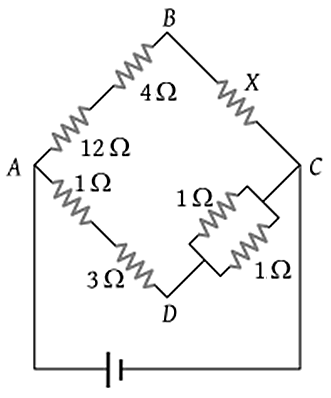In the figure, a carbon resistor has bands of different colours on its body as mentioned in the figure. The value of the resistance is:

1. \(2.2\) k\(\Omega\)
2. \(3.3\) k\(\Omega\)
3. \(5.6\) k\(\Omega\)
4. \(9.1\) k\(\Omega\)

1. \(2.2\) k\(\Omega\)
2. \(3.3\) k\(\Omega\)
3. \(5.6\) k\(\Omega\)
4. \(9.1\) k\(\Omega\)
A copper wire has a square cross-section, 2.0 mm on a side. It carries a current of 8 A and the density of free electrons is 8 × 1028 m–3. The drift speed of electrons is equal to
(1) 0.156 × 10–3 m.s–1
(2) 0.156 × 10–2 m.s–1
(3) 3.12 × 10–3 m.s–1
(4) 3.12 × 10–2 m.s–1
The equivalent resistance of the following infinite network of resistances is
(1) Less than 4 Ω
(2) 4 Ω
(3) More than 4 Ω but less than 12 Ω
(4) 12 Ω
What is the current (i) in the circuit as shown in figure
(1) 2 A
(2) 1.2 A
(3) 1 A
(4) 0.5 A
In the given figure, the equivalent resistance between the points A and B is :
(1) 8 Ω
(2) 6 Ω
(3) 4 Ω
(4) 2 Ω
Effective resistance between A and B is :
(1) 15 Ω
(2) 5 Ω
(3)
(4) 20 Ω
In the circuit shown in the figure below, if the potential difference between \(B\) and \(D\) is zero, then value of the unknown resistance \(X\) is:
| 1. | \(4~\Omega\) | 2. | \(2~\Omega\) |
| 3. | \(3~\Omega\) | 4. | EMF of a cell is required to find the value of \(X\) |
The figure below shows a network of currents. The current \(i\) will be:

1. \(3~\text{A}\)
2. \(13~\text{A}\)
3. \(23~\text{A}\)
4. \(-3~\text{A}\)
The current in the given circuit is
(1) 0.1 A
(2) 0.2 A
(3) 0.3 A
(4) 0.4 A
Eels are able to generate current with biological cells called electroplaques. The electroplaques in an eel are arranged in \(100\) rows, each row stretching horizontally along the body of the fish containing \(5000\) electroplaques. The arrangement is suggestively shown below. Each electroplaques has an emf of \(0.15\) V and internal resistance of \(0.25~\Omega\).
The water surrounding the eel completes a circuit between the head and its tail. If the water surrounding it has a resistance of \(500~\Omega\), the current an eel can produce in water is about:
| 1. | \(1.5\) A | 2. | \(3.0\) A |
| 3. | \(15\) A | 4. | \(30\) A |













